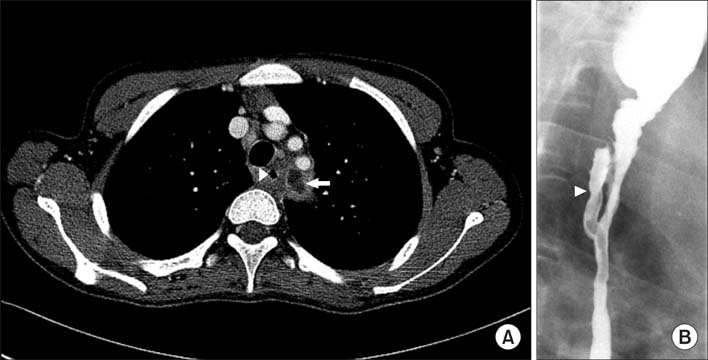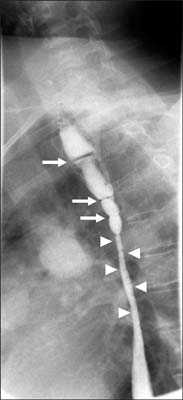Pediatr Gastroenterol Hepatol Nutr.
2016 Mar;19(1):71-75. 10.5223/pghn.2016.19.1.71.
Esophageal Stricture Secondary to Candidiasis in a Child with Glycogen Storage Disease 1b
- Affiliations
-
- 1Department of Pediatrics, Seoul National University College of Medicine, Seoul, Korea. kojs@snu.ac.kr
- 2Department of Radiology, Seoul National University College of Medicine, Seoul, Korea.
- 3Department of Laboratory Medicine, Seoul National University College of Medicine, Seoul, Korea.
- KMID: 2160478
- DOI: http://doi.org/10.5223/pghn.2016.19.1.71
Abstract
- Esophageal candidiasis is commonly seen in immunocompromised patients; however, candida esophagitis induced stricture is a very rare complication. We report the first case of esophageal stricture secondary to candidiasis in a glycogen storage disease (GSD) 1b child. The patient was diagnosed with GSD type 1b by liver biopsy. No mutation was found in the G6PC gene, but SLC37A4 gene sequencing revealed a compound heterozygous mutation (p.R28H and p.W107X, which was a novel mutation). The patient's absolute neutrophil count was continuously under 1,000/µL when he was over 6 years of age. He was admitted frequently for recurrent fever and infection, and frequently received intravenous antibiotics, antifungal agents. He complained of persistent dysphagia beginning at age 7 years. Esophageal stricture and multiple whitish patches were observed by endoscopy and endoscopic biopsy revealed numerous fungal hyphae consistent with candida esophagitis. He received esophageal balloon dilatation four times, and his symptoms improved.
MeSH Terms
Figure
Reference
-
1. Ismail A, Abdulla S. Post-monilial extensive esophageal stricture. Pediatr Hematol Oncol. 1993; 10:111–113.
Article2. Kimura H, Kurachi M, Tsukioka Y, Minami M, Itou M, Fujii H, et al. Esophageal stricture secondary to candidiasis without underlying disease. J Gastroenterol. 1995; 30:508–511.
Article3. Dahl C, Fuursted K, Schrøder H. A paediatric case of Candida pericarditis and eosophagus stricture during treatment for acute lymphatic leukaemia. Acta Oncol. 2007; 46:859–861.
Article4. Kelly K, Storey L, O'Sullivan M, Butler K, McDermott M, Corbally M, et al. Esophageal strictures during treatment for acute lymphoblastic leukemia. J Pediatr Hematol Oncol. 2010; 32:124–127.
Article5. Kim BW, Cho SH, Rha SE, Choi H, Choi KY, Cha SB, et al. Esophagomediastinal fistula and esophageal stricture as a complication of esophageal candidiasis: a case report. Gastrointest Endosc. 2000; 52:772–775.
Article6. Hyun JJ, Chun HJ, Keum B, Seo YS, Kim YS, Jeen YT, et al. Candida esophagitis complicated by esophageal stricture. Endoscopy. 2010; 42:Suppl 2. E180–E181.
Article7. Bartram CR, Przyrembel H, Wendel U, Bremer HJ, Schaub J, Haas JR. Glycogenosis type Ib complicated by severe granulocytopenia resembling inherited neutropenia. Eur J Pediatr. 1981; 137:81–84.
Article8. Andersen LI, Frederiksen HJ, Appleyard M. Prevalence of esophageal Candida colonization in a Danish population: special reference to esophageal symptoms, benign esophageal disorders, and pulmonary disease. J Infect Dis. 1992; 165:389–392.
Article9. Rake JP, Visser G, Labrune P, Leonard JV, Ullrich K, Smit GP. Glycogen storage disease type I: diagnosis, management, clinical course and outcome. Results of the European Study on Glycogen Storage Disease Type I (ESGSD I). Eur J Pediatr. 2002; 161:Suppl 1. S20–S34.
Article10. Banka S, Newman WG. A clinical and molecular review of ubiquitous glucose-6-phosphatase deficiency caused by G6PC3 mutations. Orphanet J Rare Dis. 2013; 8:84.
Article11. Han SH, Ki CS, Lee JE, Hong YJ, Son BK, Lee KH, et al. A novel mutation (A148V) in the glucose 6-phosphate translocase (SLC37A4) gene in a Korean patient with glycogen storage disease type 1b. J Korean Med Sci. 2005; 20:499–501.
Article12. Chou JY, Jun HS, Mansfield BC. Glycogen storage disease type I and G6Pase-β deficiency: etiology and therapy. Nat Rev Endocrinol. 2010; 6:676–688.
Article13. Kim SY, Jun HS, Mead PA, Mansfield BC, Chou JY. Neutrophil stress and apoptosis underlie myeloid dysfunction in glycogen storage disease type Ib. Blood. 2008; 111:5704–5711.
Article14. Pierre G, Chakupurakal G, McKiernan P, Hendriksz C, Lawson S, Chakrapani A. Bone marrow transplantation in glycogen storage disease type 1b. J Pediatr. 2008; 152:286–288.
Article15. Calderwood S, Kilpatrick L, Douglas SD, Freedman M, Smith-Whitley K, Rolland M, et al. Recombinant human granulocyte colony-stimulating factor therapy for patients with neutropenia and/or neutrophil dysfunction secondary to glycogen storage disease type 1b. Blood. 2001; 97:376–382.
Article16. Martinez-Olmos MA, López-Sanromán A, Martín-Vaquero P, Molina-Pérez E, Bárcena R, Vicente E, et al. Liver transplantation for type Ib glycogenosis with reversal of cyclic neutropenia. Clin Nutr. 2001; 20:375–377.
Article17. Adachi M, Shinkai M, Ohhama Y, Tachibana K, Kuratsuji T, Saji H, et al. Improved neutrophil function in a glycogen storage disease type 1b patient after liver transplantation. Eur J Pediatr. 2004; 163:202–206.
Article18. Kasahara M, Horikawa R, Sakamoto S, Shigeta T, Tanaka H, Fukuda A, et al. Living donor liver transplantation for glycogen storage disease type Ib. Liver Transpl. 2009; 15:1867–1871.
Article19. Yiu WH, Pan CJ, Allamarvdasht M, Kim SY, Chou JY. Glucose-6-phosphate transporter gene therapy corrects metabolic and myeloid abnormalities in glycogen storage disease type Ib mice. Gene Ther. 2007; 14:219–226.
Article
- Full Text Links
- Actions
-
Cited
- CITED
-
- Close
- Share
- Similar articles
-
- Recurrent Esophageal Stricture Caused by Candidiasis in an HIV-Infected Patient
- A Case of Glycogen Storage Disease Type IIa
- A Case of Adult Onset Glycogen Storage Myopathy
- A Novel Mutation (A148V) in the Glucose 6-phosphate Translocase (SLC37A4) Gene in a Korean Patient with Glycogen Storage Disease Type 1b
- A Case of Esophageal Candidiasis in a Healthy Child




